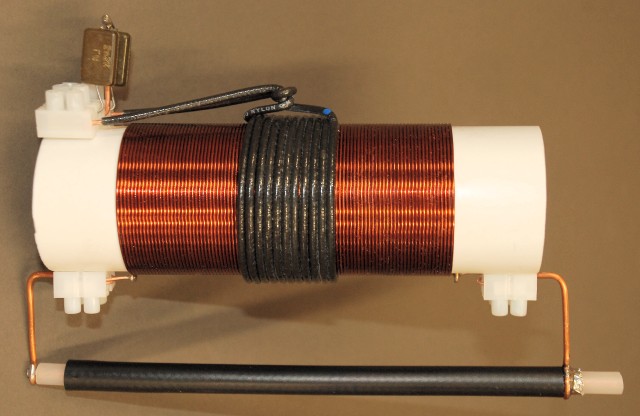
First Posted on July 19, 2012
By Ralph M. Hartwell, W5JGV

| It is important to note that this system has been designed and optimized for use with a 50 Ohm coaxial cable that measures 24 feet / 7.35 meters in length. This cable is connected between the RF source (normally the SSQ-2F v3.10 or the PA1 amplifier) and the input terminals of the RF coupler described in this article. Cable lengths of between 19 to 25 feet / 5.8 to 7.65 meters may be used with no circuit changes. Should it be desired to use a shorter cable length, please refer to the data chart at the end of this article. |
The use of commercially available RF power amplifiers to drive plasma tubes has been a common procedure for many years. However, antenna tuners have a fairly narrow bandwidth and may distort the square wave modulated RF pulses that are being sent to the plasma tube. The coupling system described in this article has been designed to eliminate this problem. It may be constructed from readily available parts by almost any experimenter.
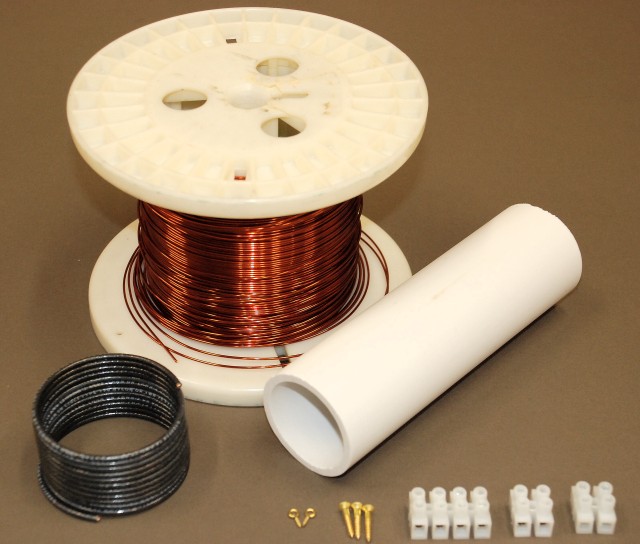
The materials required for the construction of the 3.1 MHz link coil coupler are: A 6-1/4 inch / 16 cm length of 1 1/2 inch schedule 40 PVC pipe that measures 1.9 inches/48.3 mm outside diameter, 7 feet / 2.15 meters of AWG 14 PVC insulated solid conductor copper wire, 50 feet of AWG 18 enameled copper magnet wire, two 2 conductor screw terminal strips, one 3 conductor screw terminal strip, three brass screws, #4 x 5/8", and two 1/8" eye size x 1/4" shank length brass screw eyes. Not shown in this photo is the series matching capacitor. The value of this capacitor will depend on the type of plasma tube you will be using.
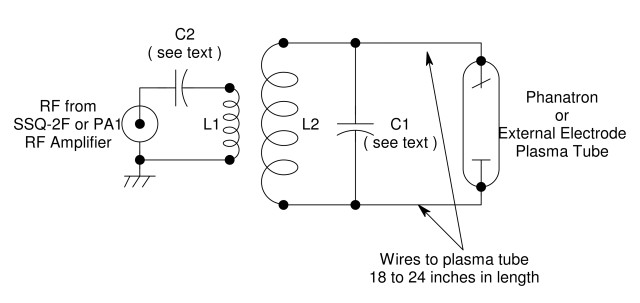
Basic circuit diagram of the 3.1 MHz link coil coupler.
Please click HERE for a PDF copy of the diagram with technical information.
Begin the construction of the coil assembly by cutting the PVC pipe to the correct length. although a length of 6 1/4 inches / 16 cm is recommended, the coil form may be cut to a longer length if desired.
Measure across the long dimension of the PVC pipe coil form, find the center of the form and place a small pencil mark there. Measure in both directions from the pencil mark towards the ends of the PVC pipe. Place another pencil mark at 2 1/8 inches / 54 mm on on either side of your mark at the center of the coil form. the distance between the two outer marks on the coil form should be 4 1/4 inches / 108 mm.
Using a small drill bit, drill a starter hole at each of the two outside marks on the coil form. Screw a brass screw eye into each of these two starter holes. The screw eye should be screwed into the coil form until the screw eye is just touching the surface of the PVC pipe. These two screw eyes will be used to anchor the ends of the secondary coil that will be connected to the plasma tube.
Now you're ready to wind the coil. The first step is to take one end of the 18 gauge copper wire and carefully remove insulation from about 2 inches / 5 cm. from the end of the wire. Using a pair of needle nose pliers, bend the wire at the point where the insulation meets the bare wire into a fairly tight, "V" shape.
Insert the free end of the wire through one of the brass screw eyes you previously installed on the coil form. The free end of the wire should be on the side of the screw eye closest to the end of the coil form. That way you will be able to wind the coil on the coil form between the two screw eyes.
Using a soldering iron, carefully but quickly, solder the wire into the screw eye. Be sure not to use excessive heat, as a PVC pipe softens rather easily, and you don't want to accidentally pull the hot screw eye out of the plastic coil form. After the solder in the screw eye has cooled for about one minute to allow the plastic to harden, press the bare end of the copper wire down against the coil form. Use some electrical tape or masking tape to cover the free end of the wire so it doesn't get caught during the winding process.
Now you're ready to actually wind the coil. when you start winding the coil, do not allow the first turn of the coil to press against the metal screw eye. If the wire is resting against the screw eye, it is possible for the installation to fail at a later time. Should that happen, it will cause detuning of the coupling system and possibly the failure of the RF amplifier.
Carefully wind the turns of the wire on the coil, making sure that the turns are pressed firmly against each other and the coil is not slanted on the form. keep the wire tight and don't let it go slack or the coil will come out looking uneven. As long as turns do not overlap each other, a slightly uneven winding will not cause any problems in operation, it just looks unsightly
Wind a total of 94 turns on the coil.
The last turn of the coil should not be pressing against the metal screw eye. There should be the width of about one wire thickness between the last turn in the screw eye.
When you have completed winding the coil, use a strip of electrical tape or masking tape wrapped around the finished and of the coil winding to prevent the wire from unwinding.
Leave about 3 inches / 7.5 cm of wire extending past the screw eye. Carefully remove the enamel insulation from the wire starting about 1/4 inch / 6 mm before the screw eye. You may find it easier to remove the insulation before you cut the excess wire off of the end of the coil winding. After the insulation has been removed from the wire, cut off the extra wire, leaving about 2 inches / 5 cm. past the screw eye.
Feed the free end of the bare wire through the brass screw eye and then bend the wire into a "V" shape just as you did at the other end of the coil winding. Solder the wire to the screw eye Be sure not to let the tension of the wire pull the screw eye loose from the coil form as you solder the wire into the screw eye.
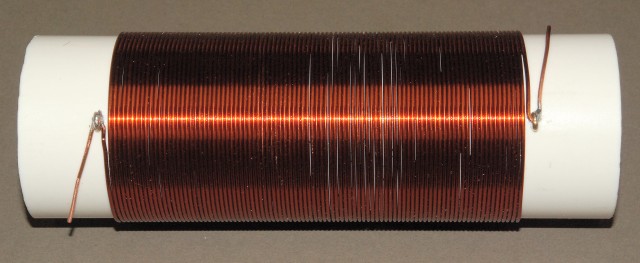
After the 18 gauge wire is wound on the PVC coil form, it should look like this. The white lines between some of the turns of wire are not gaps in the winding, but instead is light reflecting from the plastic coating that was applied to the coil to protect the wire and hold the turns in place.
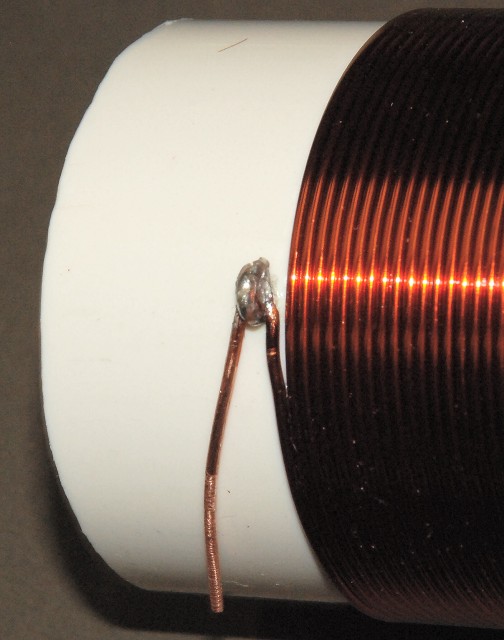
A close-up of one end of the 18 gauge wire soldered to a screw eye.
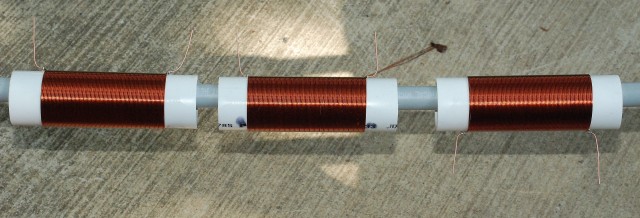
Three wound coils that have been covered with their protective plastic coating. They are drying outside in the 95°F afternoon weather. No drying oven is needed!
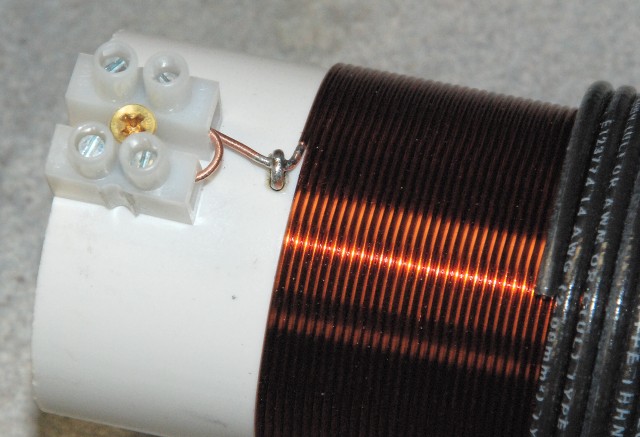
At each end of the coil form is a two position screw terminal block. The terminal blocks are attached to the coil form with of a small brass wood screw. A jumper wire is used to connect both halves of the terminal strips together. As you can see from the photo, one end of the coil winding is connected to one of the terminals of its terminal block.When the 3.1 MHz link coil coupler is placed in service one of the two connections on the terminal block will be connected to the coaxial tuning capacitor while the other terminal of that same terminal block will be connected to one of the two wires that connects thecoupler assembly to the plasma tube.
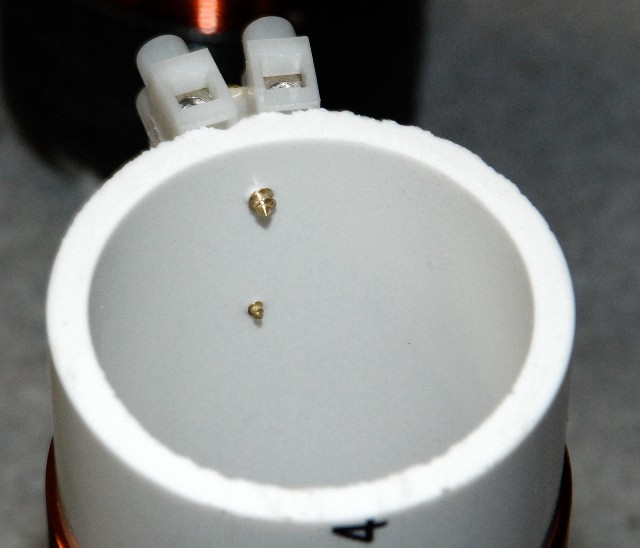
This picture shows the mounting screw for the terminal strip and the brass screw eye at the end of the coil winding. They protrude through the coil for a short distance into the center oft he coil form. When handling the link coupler assembly please be careful not to accidentally cut yourself on these screws. Only brass hardware should be used on the coupler. Steel or iron hardware will cause increased RF loss.
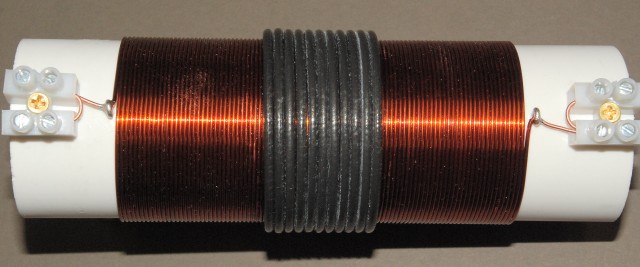
This is what the assembly should look like after the 18 gauge coil is wound. This picture was taken after the primary link coil was wound over the secondary coil. In this picture, both of the terminal strips have been installed on the coil form. The ends of the coil winding have been connected to one of the connections on each terminal block and jumper wires have been installed on the terminal blocks. The jumper wires electrically connect both terminals of each block together. The two wires from the plasma tube will connect to one terminal on each terminal block and the two wires from the tuning capacitor will connect to the other connections on the terminal blocks, one at each end of the coil
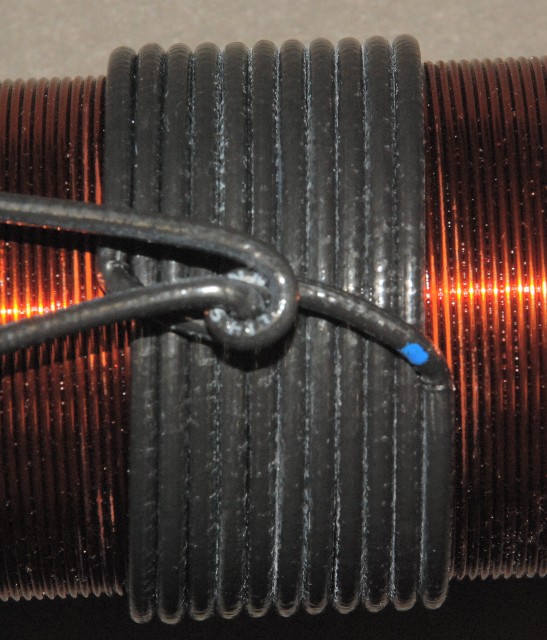
Now it's time to wind the primary link coil over the secondary coil. The coil requires approximately 7 to 7 1/2 feet / 2.14 to 2.3 meters of AWG 14 PVC insulated solid conductor copper wire. the wire is wound tightly around the secondary coil until a total of 11 full turns have been wound on the coil. Then the free ends of the coil winding are bent at right angles towards the center of the coil and twisted around each other as seen in the photograph above. When properly done this will hold the wire tightly against the secondary coil. The twist in the wires should be placed exactly halfway around the coil from the terminal strips that are connected to the secondary coil. The free ends of the primary link winding are then formed so that they point to one end of the coil form.
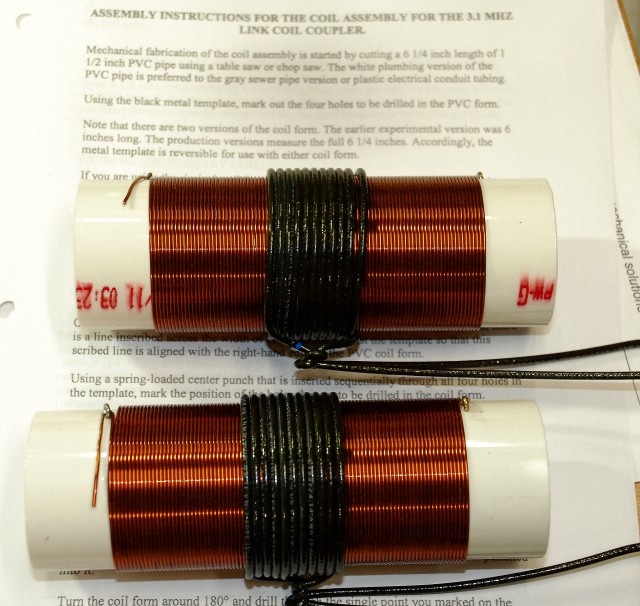
These are two prototype 3.1 MHz link coil coupler assemblies which have the primary and secondary coils in place, but no terminal blocks have been installed.
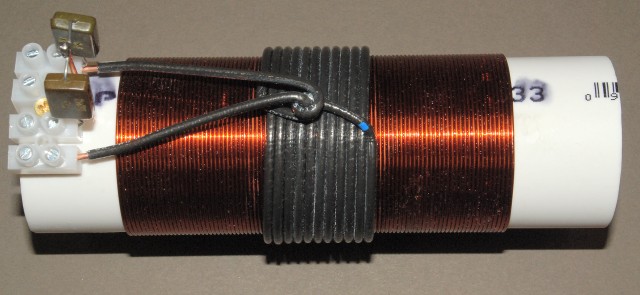
In order to get the 3.1 MHz link coil coupler to operate properly it is necessary to insert a series tuning capacitor in one of the connecting leads to the primary link coil. This is most conveniently done by using several fixed capacitors mounted on a terminal strip at one end of the coil form. In this particular unit a four position screw terminal block is used. It is attached to the PVC coil form using a small brass wood screw in the same manner as the other two terminal strips.
One end of the coil winding goes directly to one of the screw terminals. This connection to the coil will be attached to the shield of the coaxial cable coming from the SSQ-2F v3.10 or the PA1.
The other end of the primary link coil winding goes to the screw terminal at the other end of the terminal strip. In this particular arrangement, there are two 2200 pF Mica link tuning capacitors that are connected in series. One end of the two series connected tuning capacitors is connected to one end of the primary link coil winding (the upper black wire in this photo), and the other end of the two capacitors is connected to the screw terminal immediately above the other end of the primary link coil winding (the lower black wire in this photo.) The connection to the junction of the two capacitors is brought out to the third terminal on the screw terminal block.
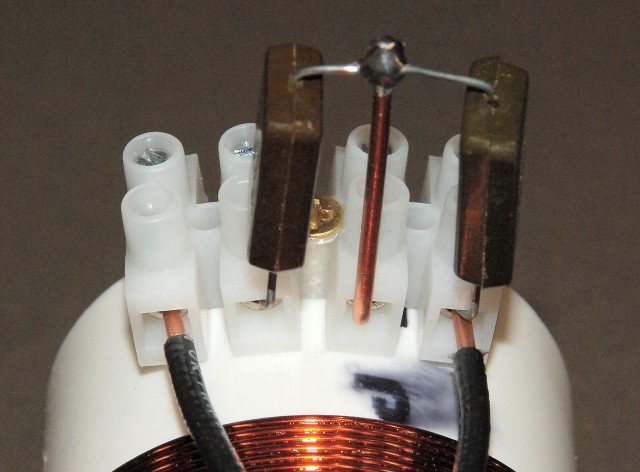
This photograph shows the way the wires from the primary link coil and the series tuning capacitors are connected to the terminal strip.
The shield of the coaxial cable that connects to the terminal block connection is connected to the black wire at the left side of this picture. The center wire of the coaxial cable connects to the terminal block connection that is just to the right of the left-most black wire.
What connected in this manner, the effective tuning capacitance is 1100 pF. By inserting a jumper across the right-hand to connections of the terminal block the right-hand capacitor will be bypassed. This will result in an effective tuning capacitance of 2200 pF. Should you wish an even wider tuning range, the fixed Mica capacitors may be removed and a variable capacitor installed in their place.
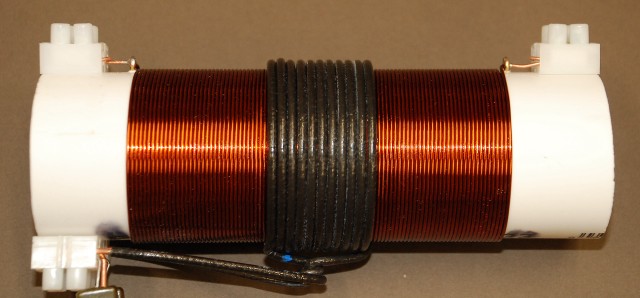
Looking at the completed 3.1 MHz link coil coupler assembly from the side - showing how the terminal blocks and primary link coil are arranged.
Note that the wires from the primary link coil are spaced away from the 18 gauge secondary winding. Is important to do this. If the primary coil wires are pressed against the secondary winding it will cause improper operation due to detuning of the secondary coil. This may also result in insulation failure due to a high-voltage RF arc which may occur at high power levels.
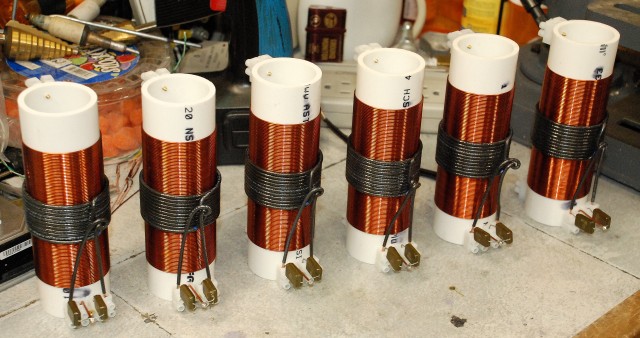
A set of six completed 3.1 MHz link coil coupler assemblies awaiting final test and inspection before shipment.
In order for the 3.1 MHz link coil coupler to operate properly, it is necessary to have some additional tuning capacitance placed across the 18 gauge secondary coil to bring it to resonance at 3.1 MHz. While it is theoretically possible to obtain all of the required tuning capacitance by using the distributed capacity between the wires that connect the 3.1 MHz link coil coupler to the plasma tube, it is very difficult to accurately control the amount of capacity due to physical placement of the wire, proximity to other objects, and other environmental variables. It is necessary to provide a stable value of capacity for the system to work reliably and not require constant adjustment, and ” touching up."
From an engineering perspective the best approach to solving this problem is to use a variable capacitor. Unfortunately, high voltage variable capacitors are very expensive. In order to provide a reliable solution at a low-cost, it was decided to use a length of coaxial cable to provide the necessary tuning capacity. For this particular application, coaxial cable is an ideal solution. At an operating frequency of 3.1 MHz, the RF loss in even a long length of this coaxial cable is very low. By using a large diameter cable, such as RG-213, a reasonable amount of capacitance per inch of cable is obtained , as well as a very high voltage rating. The result, when properly constructed, is a capacitor of reasonable size, low cost, and high reliability.
In order for this capacitor to work effectively, it is necessary to specify an approximate upper and lower limit for the length of the wires which connect the 3.1 MHz link coil coupler to the plasma tube. With the values chosen for this system, wire lengths of between 18 to 24 inches / 46 to 76 cm are satisfactory. The system has been optimized to work with a length of 24 inches / 61 cm. The diameter of the wire is not particularly critical, and any convenient size mayu be used. The wire should have reasonable insulation and it should be capable of handling 2000 Volts. It is necessary to keep the wires between the 3.1 MHz link coil coupler and the plasma tube away from anything that is metal to prevent the tuning of the system or an RF arc through the wire insulation. The wires should be spaced no further apart than necessary. Excessively wide wire spacing causes unwanted RF radiation.
CONSTRUCTION OF THE COAXIAL CAPACITORS
In order to construct the coaxial tuning capacitors for the 3.1 MHz link coil coupler assembly, you will need several feet of large diameter, solid dielectric, 50 ohm coaxial cable, such as RG-213 or RG-8/U. depending on the type of plasma tube you are going to use with your 3.1 MHz link coil coupler system, the length of the finished coaxial tuning capacitor will vary slightly. The use of smaller cable, such as RG-58/U is not recommended. Smaller cable will not be satsfactory at high power levels, and may fail due to insulation failure and electrical arcing.
CONSTRUCTION OF THE COAXIAL CAPACITORS
Please refer to the picture below. The distance measured between the edge of the black outer jacket of the coaxial cable seen at the left-hand side of the picture and the far edge of the exposed copper shield seen in the right-hand side of the picture is called the “active length" of the capacitor. The center lead of the coaxial cable extends all the way from the left to the right-hand side of the section of cable, but the outer shield braid is cut off approximately 1/2 inch from each end of the cable. The actual active portion of the capacitor is that area under the shield.
The white polyethylene insulation must extend past the ends of the shield in order to prevent an RF arc when power is applied to the system. Electrical connections are made to the two ”plates" of the capacitor by making connections to the center wire and the shield of the coaxial cable. The center wire of the coaxial cable is one plate of the capacitor and the shield of the coaxial cable is the other plate of the capacitor.
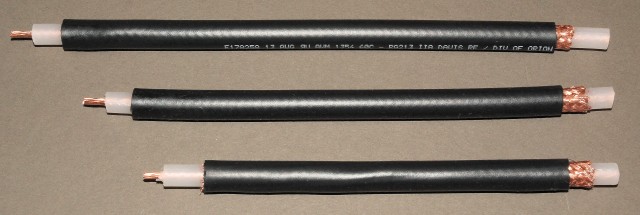
Here are three coaxial tuning capacitors cut to the proper length for three different types of plasma tubes.
The top capacitor is for use with a Cheb 8 inch Phanotron tube. It measures 8 inches overall length, and the active portion of the capacitor is 7 inches long.
The middle capacitor is for use with a Cheb SSQ-PT 1" x 14" plasma tube. It measures 7 inches overall length, and the active portion of the capacitor is 6 inches long.
The bottom capacitor is for use with an experimental plasma tube. It measures 6 inches overall length, and the active portion of the capacitor is 5 inches long.
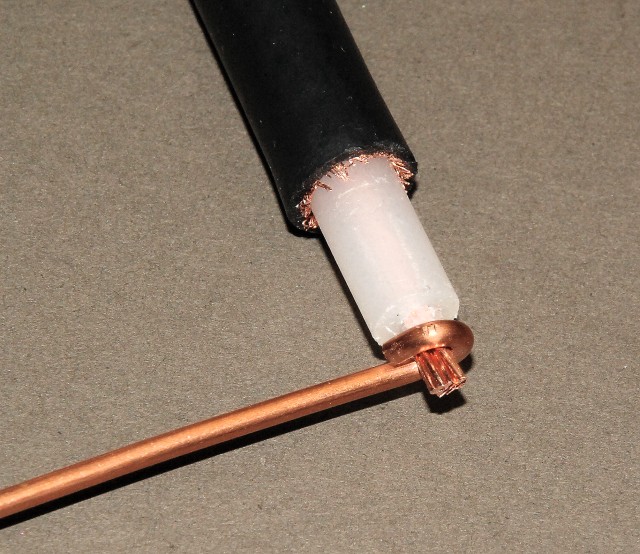
Connections are made to the ends of the coaxial tuning capacitors by using some bare copper wire that is bent to fit around the exposed shield and center conductor of the coaxial cable. After forming the leads in place, they are soldered to the shield braid and center wire of the coaxial cable. After soldering to the connecting wire to the center wire of the coaxial cable, any excess center wire sticking out wast the solder joint may be cut off.
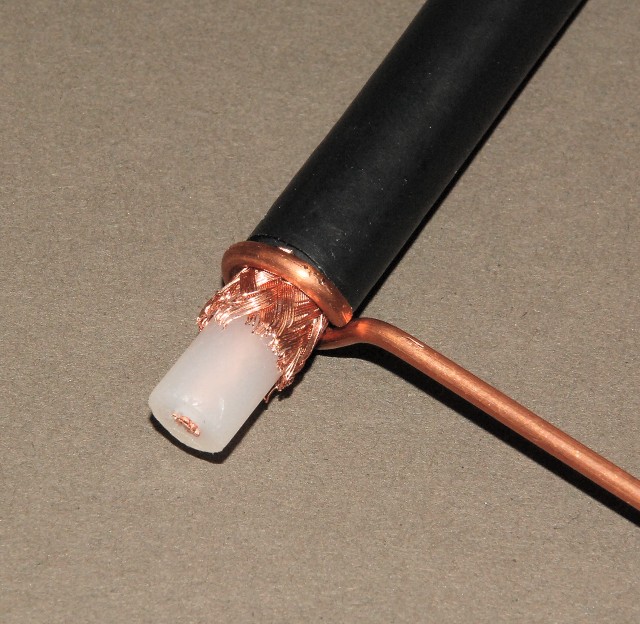
The connection to the shield braid is made similar to the connection tothe center wire of the coaxial cable. A length of copper wire is carefully formed into a circle and gently squeezed in place around the shield braid. It is then soldered in place.
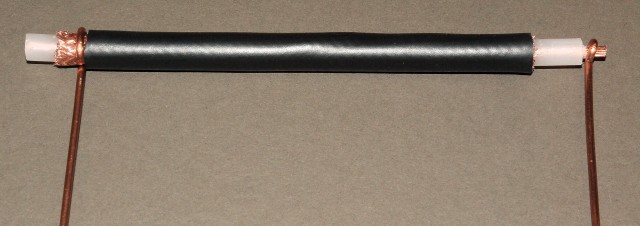
A picture of one of the coaxial capacitors prior to soldering the connecting wires to the shield braid and the center wire.
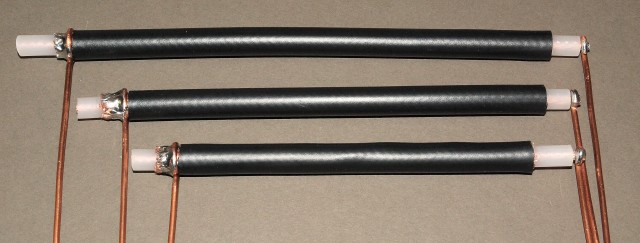
The connecting wires have been soldered to all three of the coaxial tuning capacitors. The leads have not yet been cut to length or formed to fit the coil assembly.

This coaxial tuning capacitor has had its wire leads bent and cut to the proper length to fit into the screw terminal blocks on the ends of the 3.1 MHz link coil coupler assembly.
The distance between the axis of the coaxial cable and the bend in the connecting wire is approximately 1.5 inches / 3.8 cm. The exact distance is not critical, but the coaxial cable capacitor should be spaced at least 1 inch / 2.54 cm away from the surface of the coil to prevent possible detuning of the 3.1 MHz link coil coupler.
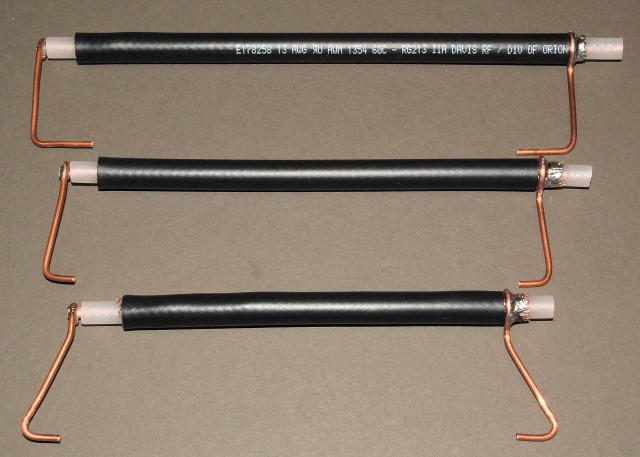
All three of the coaxial tuning capacitors seen in trhis picture have had their leads cut to length and properly shaped so that they will fit into the terminal blocks on the 3.1 MHz link coil coupler assembly.
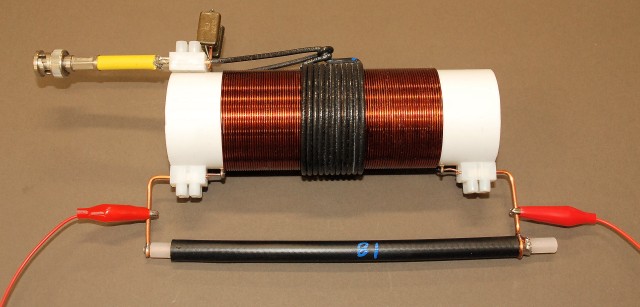
A completed 3.1 MHz link coil coupler ready for final testing.
This is a temporary test setup, so a pair of clip leads have been used to connect the output of the 3.1 MHz link coil coupler to the plasma tube instead of more permanent wires. In actual use, the wires from the plasma tube would be attached directly to the screw terminals thatb are visible at either end of the coil assembly.
The short yellow coaxial cable is extended back to the output of the SSQ-2F v3.10 or the PA1 during the test process. In this particular setup, the coaxial capacitor chosen for use is the one required to operate with a Cheb 8 inch Phanotron tube. Because a series link resonating capacitance of approximately 1100 pF is required for use with the Phanotron tube, no jumper is installed in the terminal block.
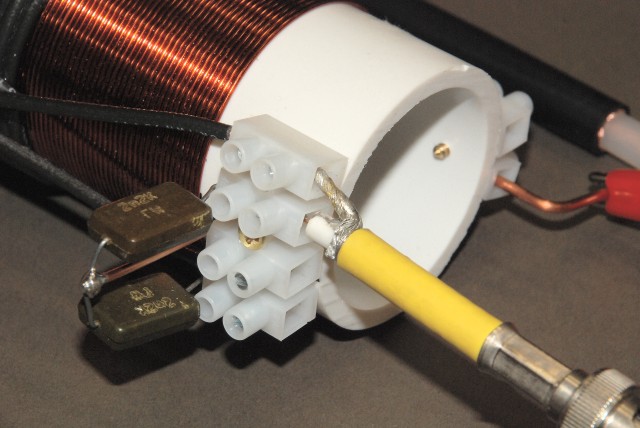
A close-up photograph showing the connection of the coaxial cable to the link coil terminal block.
Although a short length of coaxial cable was used for this photograph, in normal operation, the coaxial cable would extend from the 3.1 MHz link coil coupler terminal block all the way back to the output of the SSQ-2F v3.10 or the PA1. Because there is no shorting jumper placed across the two lower screw terminal connections, we know that the series tuning capacitance is 1100 pF. Had the jumper been connected to the terminal block, the series tuning capacitor would be 2200 pF.
| This coupling system has been
designed and optimized for use with a 50 Ohm coaxial cable that
measures 24 feet / 7.35 meters in length. This cable is connected
between the RF source (normally the SSQ-2F v3.10 or the PA1 amplifier)
and the input terminals of the RF coupler described in this article. Cable lengths of between 19 to 25 feet / 5.8 to 7.65 meters may be used with no circuit changes. Should it be desired to use a shorter cable length, it will be necessary to change the value of the link series tuning capacitor, which is normally either 2200 pF or 1100 pF. In general, the shorter the cable length, the greater will be the required tuning capacitance. In some cases, there may be no series tuning capacitor required. What happens is that is as the value of the tuning capacitance is reduced, the link coil approaches the condition of series resonance. This causes the load resistance as seen by the RF source to decrease. Because the SSQ-2F v3.10 and the PA1 amplifier are voltage sources, as the load on the RF amplifier is decreased as the link coil approaches resonance, the output MOSFET transistor in the RF amplifier stage will try to supply the power demanded by the load. This will cause the output transistor to draw excessive current and fail. For this reason, when changing cable lengths it will be necessary to carefully monitor the drain current of the amplifier and adjust the DC supply voltage to the amplifier to provide sufficient output while not allowing the output transistor to draw enough current to fail. In normal operation, the 3.1 MHz link coil coupler described in this article is operated with the series link tuning capacitor adjusted so that that the circuit is tuned below resonance. This is the most favorable condition for the output amplifier in the SSQ-2F v3.10 or the PA1. Operating the system below resonance allows the output transistor to operate at a higher voltage point but with a lower current. This results in reduced losses in the output transistor and decreases the heat the output transistor has to dissipate. Cable length and Coaxial Capacitor data for the 3.1 MHz link coil coupler Cheb 8 inch Phanotron Use with 7-inch active length coaxial capacitor and 24 inch / 61 cm connecting wires. 3 feet to 10 feet or 1 m to 3 m = 1 series capacitor, 2200 pF. 19 feet to 24 feet or 5.8 m to 7.3 m = 2 series capacitors, 2200 pF each total 1100 pF. SSQ-PT - 1" x 14" straight external electrode tube with 1.25 inch / 31.75 mm collar electrodes Use with 6-inch active length coaxial capacitor and 24 inch / 61 cm connecting wires. 3 feet to 10 feet or 1 m to 3 m = no series capacitors. 19 feet to 24 feet or 5.8 m to 7.3 m = 1 series capacitor, 2200 pF. |
This page and all text, data and photographs are Copyright © 2012 - 2018 by Ralph M. Hartwell II, All Rights Reserved.